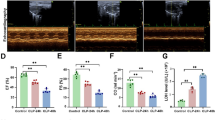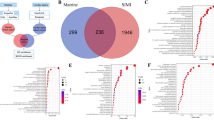Abstract
Sepsis is the systemic inflammatory response caused by infection. Cardiac dysfunction is an acknowledged result of sepsis. Shengjiang Powder, a prescribed traditional Chinese medicine, showed anti-infection and antipyretic functions in our previous study. In this study, we established a septic rat model via cecal ligation puncture (CLP) to evaluate the effects of Shengjiang Powder on sepsis and the involvement of P38 mitogen activated protein kinase (P38-MAPK) signaling. The 10 main ingredients of Shengjiang Powder were identified by LC–MS. The results of this study indicated that Shengjiang Powder at a concentration of 3.0 g/kg with SB203580 (an inhibitor of P38-MAPK) could improve myocardial injury, ameliorate the histopathological abnormalities, decrease apoptosis and upregulate proliferating cell nuclear antigen (PCNA) levels in myocardial tissues. Further, cytokine mRNA expression levels (tumor necrosis factor - alpha, TNF-α and interleukin 6, IL-6) were decreased by Shengjiang Powder and SB203580 in the myocardial tissues. Furthermore, the p-P38 protein level in myocardial tissues was upregulated in septic rats but decreased upon treatment with Shengjiang Powder and SB203580; however, the relative protein level of P38 showed no significant changes. Collectively, Shengjiang Powder showed a myocardial protective effect on rats with CLP-induced sepsis.





Similar content being viewed by others
References
Blumer MJ, Longato S and Fritsch H 2008 Structure, formation and role of cartilage canals in the developing bone. Ann. Anat. 190 305–315
Cohen J, Vincent J-L, Adhikari NKJ, Machado FR, Angus DC, Calandra T, Jaton K, Giulieri S, Delaloye J, Opal S, Tracey K, van der Poll T and Pelfrene E 2015 Sepsis: a roadmap for future research. Lancet Infect. Dis. 15 581–614
Court O, Kumar A, Parrillo JE and Kumar A 2002 Clinical review: myocardial depression in sepsis and septic shock. Crit. Care 6 500–508
Derogis PBM, Sanches LR, de Aranda VF, Colombini MP, Mangueira CLP, Katz M, Faulhaber ACL, Mendes CEA, Ferreira CEDS, França CN and Guerra JCdC 2017 Determination of rivaroxaban in patient’s plasma samples by anti-XA chromogenic test associated to high performance liquid chromatography tandem mass spectrometry (HPLC-MS/MS). PLoS ONE 12 e0171272
Dong X 2014 Treatment of tuberculous exudative pleurisy by Jiawei Shengjiangsan decoction for 50 cases. Chin. Med. Mod. Distance Educ. China 12 28–29
Fleischmann C, Scherag A, Adhikari NKJ, Hartog CS, Tsaganos T, Schlattmann P, Angus DC and Reinhart K 2015 Assessment of global incidence and mortality of hospital-treated sepsis. Current estimates and limitations. Am. J. Respir. Crit. Care Med. 193 259–272
Garat C and Arend WP 2003 Intracellular IL-1Ra type 1 inhibits IL-1-induced IL-6 and IL-8 production in Caco-2 intestinal epithelial cells through inhibition of p38 mitogen-activated protein kinase and NF-κB pathways. Cytokine 23 31–40
Hollenbach E, Neumann M, Vieth M, Roessner A, Malfertheiner P and Naumann M 2004 Inhibition of p38 map kinase- and RICK/NF-KAPPAB-signaling suppresses inflammatory bowel disease. FASEB J. 18 1550–1552
Kell DB and Pretorius E 2018 To what extent are the terminal stages of sepsis, septic shock, systemic inflammatory response syndrome, and multiple organ dysfunction syndrome actually driven by a prion/amyloid form of fibrin? Semin. Thromb. Hemost. 44 224–238
Lee JC, Laydon JT, McDonnell PC, Gallagher TF, Kumar S, Green D, McNulty D, Blumenthal MJ, Heys JR, Landvatter SW, Strickler JE, McLaughlin MM, Siemens IR, Fisher SM, Livi GP, White JR, Adams JL and Young PR 1994 A protein kinase involved in the regulation of inflammatory cytokine biosynthesis. Nature 372 739–746
Levy MM, Fink MP, Marshall JC, Abraham E, Angus D, Cook D, Cohen J, Opal SM, Vincent J-L, Ramsay G and F.t.I.S.D. Conference 2003 2001 sccm/esicm/accp/ats/sis international sepsis definitions conference. Crit. Care. Med. 31 1250–1256
Li X, Xiao H, Liang X, Shi D and Liu J 2004 LC–MS/MS Determination of naringin, hesperidin and neohesperidin in rat serum after orally administrating the decoction of Bulpleurum falcatum L. and Fractus aurantii. J. Pharm. Biomed. Anal. 34 159–166
Li H, Yang T, Zhou H, Du J, Zhu B and Sun Z 2016 Emodin combined with nanosilver inhibited sepsis by anti-inflammatory protection. Front. Pharmacol. 7 536
Ma L, Li H, Zhang S, Xiong X, Chen K, Jiang P, Jiang K and Deng G 2018 Emodin ameliorates renal fibrosis in rats via TGF-beta1/SMAD signaling pathway and function study of SMURF 2. Int. Urol. Nephrol. 50 373–382
Nan SL, Pan J, Zhang J, Zhao L and Fang XM 2011 Effect of Shengjiangsan on levels of IL-1β and IL-10 in serum in mouse infected by influenza virus FM1. J. Liaoning Univ. Trad. Chin. Med. 13 70–71
Nho J-H, Jung H-K, Lee M-J, Jang J-H, Sim M-O, Jeong D-E, Cho H-W and Kim J-C 2018 Beneficial effects of cynaroside on cisplatin-induced kidney injury in vitro and in vivo. Toxicol. Res. 34 133–141
Paul M, Shani V, Muchtar E, Kariv G, Robenshtok E and Leibovici L 2010 Systematic review and meta-analysis of the efficacy of appropriate empiric antibiotic therapy for sepsis. Antimicrob. Agents Chemother. 54 4851–4863
Peng W, Qiu X-Q, Shu Z-H, Liu Q-C, Hu M-B, Han T, Rahman K, Qin L-P and Zheng C-J 2015 Hepatoprotective activity of total iridoid glycosides isolated from Paederia scandens (Lour.) Merr. var. tomentosa. J. Ethnopharmacol. 174 317–321
Potz BA, Sellke FW and Abid MR 2016 Endothelial ROS and impaired myocardial oxygen consumption in sepsis-induced cardiac dysfunction. J. Intensive Crit. Care 2 20
Rudiger A and Singer M 2007 Mechanisms of sepsis-induced cardiac dysfunction. Crit. Care. Med. 35 1599–1608
Schindler JF, Monahan JB and Smith WG 2007 P38 pathway kinases as anti-inflammatory drug targets. J. Dent. Res. 86 800–811
Sreekanth GP, Chuncharunee A, Sirimontaporn A, Panaampon J, Noisakran S, Yenchitsomanus P-t and Limjindaporn T 2016 Sb203580 modulates p38 MAPK signaling and dengue virus-induced liver injury by reducing mapkapk2, hsp27, and atf2 phosphorylation. PLoS ONE 11 e0149486
Stirling DP, Liu J, Plunet W, Steeves JD and Tetzlaff W 2008 Sb203580, a p38 mitogen-activated protein kinase inhibitor, fails to improve functional outcome following a moderate spinal cord injury in rat. Neuroscience 155 128–137
Supinski GS and Callahan LA 2006 Polyethylene glycol–superoxide dismutase prevents endotoxin-induced cardiac dysfunction. Am. J. Respir. Crit. Care Med. 173 1240–1247
Supinski GS, Wang W and Callahan LA 2009 Caspase and calpain activation both contribute to sepsis-induced diaphragmatic weakness. J. Appl. Physiol. 107 1389–1396
Udani M, Zen Q, Cottman M, Leonard N, Jefferson S, Daymont C, Truskey G and Telen MJ 1998 Basal cell adhesion molecule/lutheran protein. The receptor critical for sickle cell adhesion to laminin. J. Clin. Invest. 101 2550–2558
van der Poll T and van Deventer SJH 1999 Cytokines and anticytokines in the pathogenesis of sepsis. Infect. Dis. Clin. North. Am. 13 413–426
Vincent J-L, Opal SM, Marshall JC and Tracey KJ 2013 Sepsis definitions: time for change. Lancet (London, England) 381 774–775
Walkey AJ, Lagu T and Lindenauer PK 2015 Reply: Trends in sepsis and infection sources in the United States. A population-based study. Ann. Am. Thorac. Soc. 12 785
Wang X, Niu C, Zhang X and Dong M 2018 EMODIN suppresses activation of hepatic stellate cells through p38 mitogen-activated protein kinase and SMAD signaling pathways in vitro. Phytother. Res. 32 2436–2446
Xia YC, Guo J and Zhou XG 2013 Clinical observation of effects of Shengjiangsan on the kidney in patients with sepsis. J. Emerg. Trad. Chin. Med. 22 214–215
Yang M, Wu J, Martin CM, Kvietys PR and Rui T 2008 Important role of p38 map kinase/nf-κb signaling pathway in the sepsis-induced conversion of cardiac myocytes to a proinflammatory phenotype. Am. J. Physiol. Heart Circ. Physiol. 294 H994–H1001
Yuki K and Murakami N 2015 Sepsis pathophysiology and anesthetic consideration. Cardiovasc. Hematol. Disord. Drug. Targets. 15 57–69
Zanotti-Cavazzoni SL and Hollenberg SM 2009 Cardiac dysfunction in severe sepsis and septic shock. Curr. Opin. Crit. Care 15 392–397
Zarubin T and Han J 2005 Activation and signaling of the p38 map kinase pathway. Cell Res. 15 11–18
Zehendner CM, Luhmann HJ and Yang JW 2013 A simple and novel method to monitor breathing and heart rate in awake and urethane-anesthetized newborn rodents. PLoS ONE 8 e62628
Zhang M, Wang X, Bai B, Zhang R, Li Y and Wang Y 2016 Oxymatrine protects against sepsis-induced myocardial injury via inhibition of the tnf-α/p38-mapk/caspase-3 signaling pathway. Mol. Med. Rep. 14 551
Zhang F, Zhang JG, Yang W, Xu P, Xiao YL and Zhang HT 2018 6-gingerol attenuates LPS-induced neuroinflammation and cognitive impairment partially via suppressing astrocyte overactivation. Biomed. Pharmacother. 107 1523–1529
Acknowledgements
This work was funded by National Natural Science Foundation of China Youth Foud (No. 81303101).
Author information
Authors and Affiliations
Corresponding author
Ethics declarations
Animal rights statement
All animal protocols were strictly in accordance with the international ethical guidelines and the National Institutes of Health Guide concerning the Care and Use of Laboratory Animals, and the protocols were approved by the Animal Experimentation Ethics Committee of Shanghai University of Traditional Chinese Medicine.
Additional information
Communicated by Dipankar Nandi.
Corresponding editor: Dipankar Nandi
Rights and permissions
About this article
Cite this article
Qian, Y., Qian, F., Zhang, W. et al. Shengjiang Powder ameliorates myocardial injury in septic rats by downregulating the phosphorylation of P38-MAPK. J Biosci 44, 40 (2019). https://doi.org/10.1007/s12038-019-9857-7
Received:
Accepted:
Published:
DOI: https://doi.org/10.1007/s12038-019-9857-7




